Who Are the Developers Working on Generative AI Projects?
 Richard MuirData Journalist
Richard MuirData Journalist
SlashData
Developers Working With AI: Who, What, Where
Generative AI has exploded into the public consciousness with the advent of products such as ChatGPT, VALL-E, and Midjourney, which allow anybody to create prose, voice, and images from a simple input. However, these popular examples of generative AI are the tip of the iceberg; new products and services are being released every day, often underpinned by foundational generative AI models which are accessed through APIs. Software developers play a key role in making this technology accessible to the consumer.
In this article, we explore key information about the developers working on generative AI projects: Where they are located, which roles they have, their level of experience and education, and what tools they use. We also cover where these developers go to get information about software development and which types of content they use to stay up to date. The data comes from the 24th edition of the Developer Nation Survey by SlashData, which includes responses from more than 23,000 developers about their involvement in generative AI and other emerging technologies.
Learn more about the mechanics of ML models in this full guide to AI inference.
63% of Developers Are Engaged With AI-Assisted Development
Of the two technologies, AI-assisted software development garners more engagement than generative AI, perhaps because of the direct impact on developers’ day-to-day work. We see that 11% of developers report that they are currently working on AI-assisted development. In our view, it’s unlikely that all of these developers are building or integrating AI coding solutions. Rather, many are likely utilizing this technology in their development activities. We also see that nearly one in five developers are learning about AI-assisted development–this represents a sizable proportion of developers who may incorporate this technology into their workflows in the future.
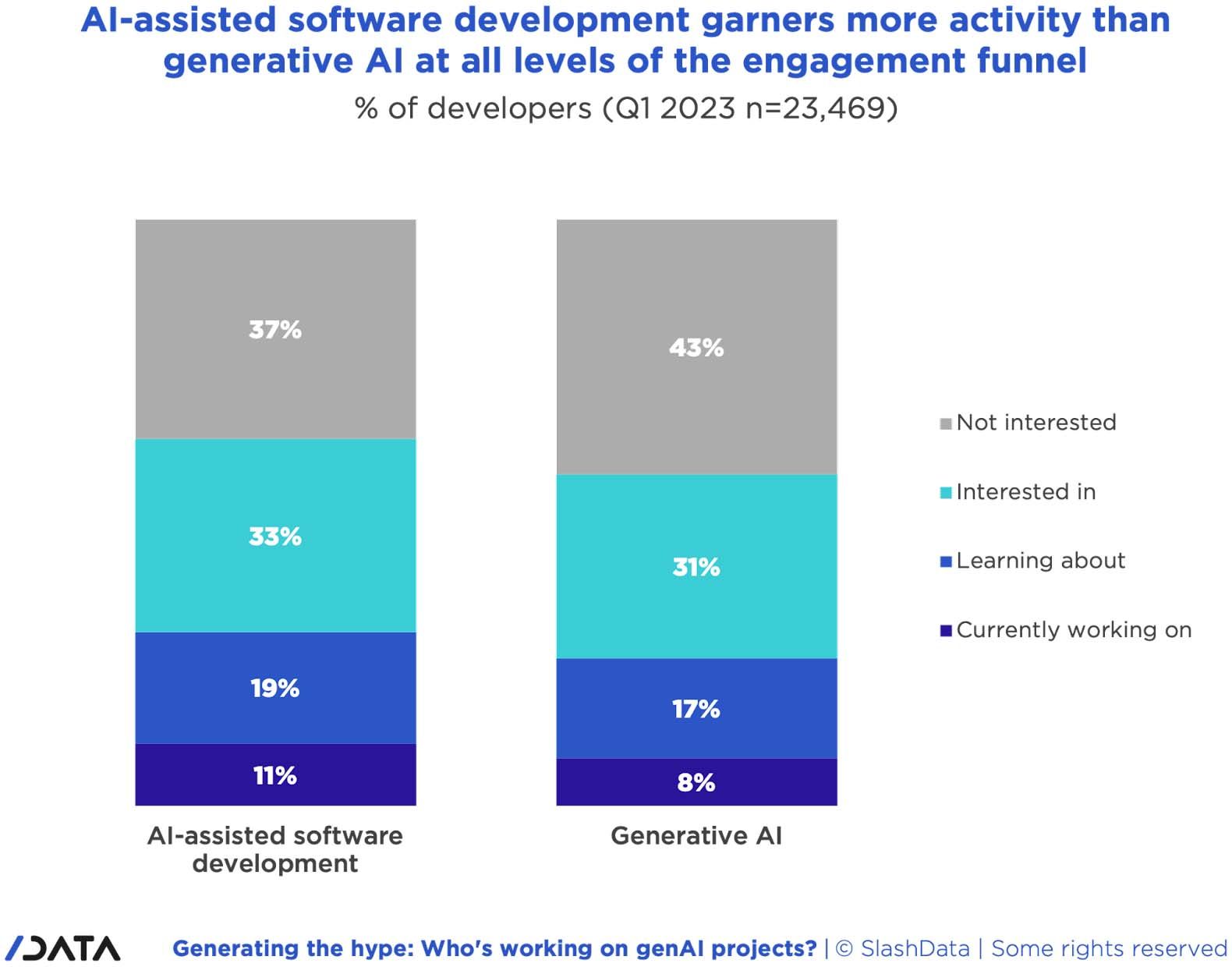
Taking a regional view, we find that North America is clearly the hotspot for developers involved in generative AI projects. Nearly three in ten (29%) of those currently working on generative AI projects and 28% of those working on AI-assisted development live here. Developers currently working on generative AI projects are more than 50% more likely to live in North America than the average developer, even though only 18% of all developers live in this region.
Our research reveals the opposite situation in Western Europe, where the population of developers working on generative AI projects is smaller than we would expect, given the proportion of all developers that live here. Similar to North America, 18% of all developers are located in Western Europe, but only 15% of developers are currently working on generative AI projects, suggesting there may be room for Western Europe to grow its population of developers working on generative AI projects. Indeed, the UK government has released a white paper detailing its strategy for ensconcing generative AI as a key part of its technology strategy.
Elsewhere, we see that comparatively few developers working on generative AI projects live in South Asia and the Greater China area–there are around 50% fewer such developers here than we would expect–8% and 7%, respectively, given the overall proportion of developers–12% and 11%. So these regions also seem positioned to take advantage of the generative AI gold rush by attracting, encouraging, or training more developers to become involved in generative AI. However, gaining regulatory approval and support may be more difficult, especially in the Greater China area, despite a large private investment in the chips needed to power generative AI solutions.
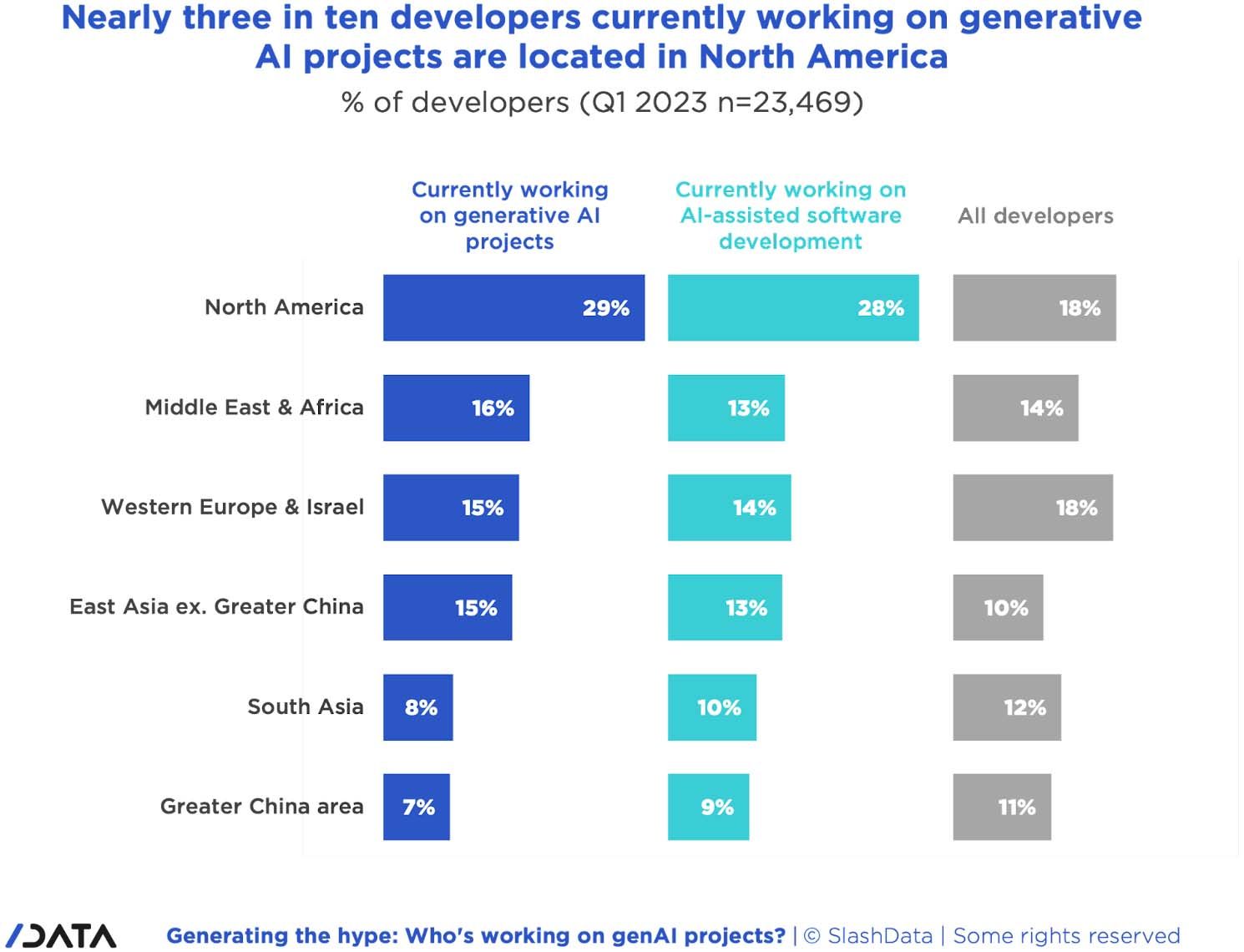
Nearly Three in Ten Developers Currently Working on Generative AI Projects Are Located in North America
Flexibility and Expertise: Two Requisites for Developers in Generative AI
In terms of experience, we see that developers working on generative AI–including AI-assisted development–are much more likely to have middling levels of experience–between three and ten years–than the average software developer. To put this another way, there are comparatively fewer very experienced and very inexperienced developers than we would expect. So, working on generative AI software projects may require a mix of flexibility and experience to take on these challenging projects. Perhaps less-experienced developers have not yet built the necessary skills to make meaningful contributions, while more-experienced and specialized developers may not be in a position to pivot as quickly.

We also see that developers working on generative AI projects tend to be highly skilled and educated in terms of how they learned to code. Involvement in generative AI software projects seems linked to a higher level of education–developers involved in these projects are more than 50% more likely to have a postgraduate degree in computing and much less likely to be self-taught. Furthermore, very few developers involved in generative AI don’t know how to code. In other words, no-code and low-code solutions may still take time to make a difference in this market.
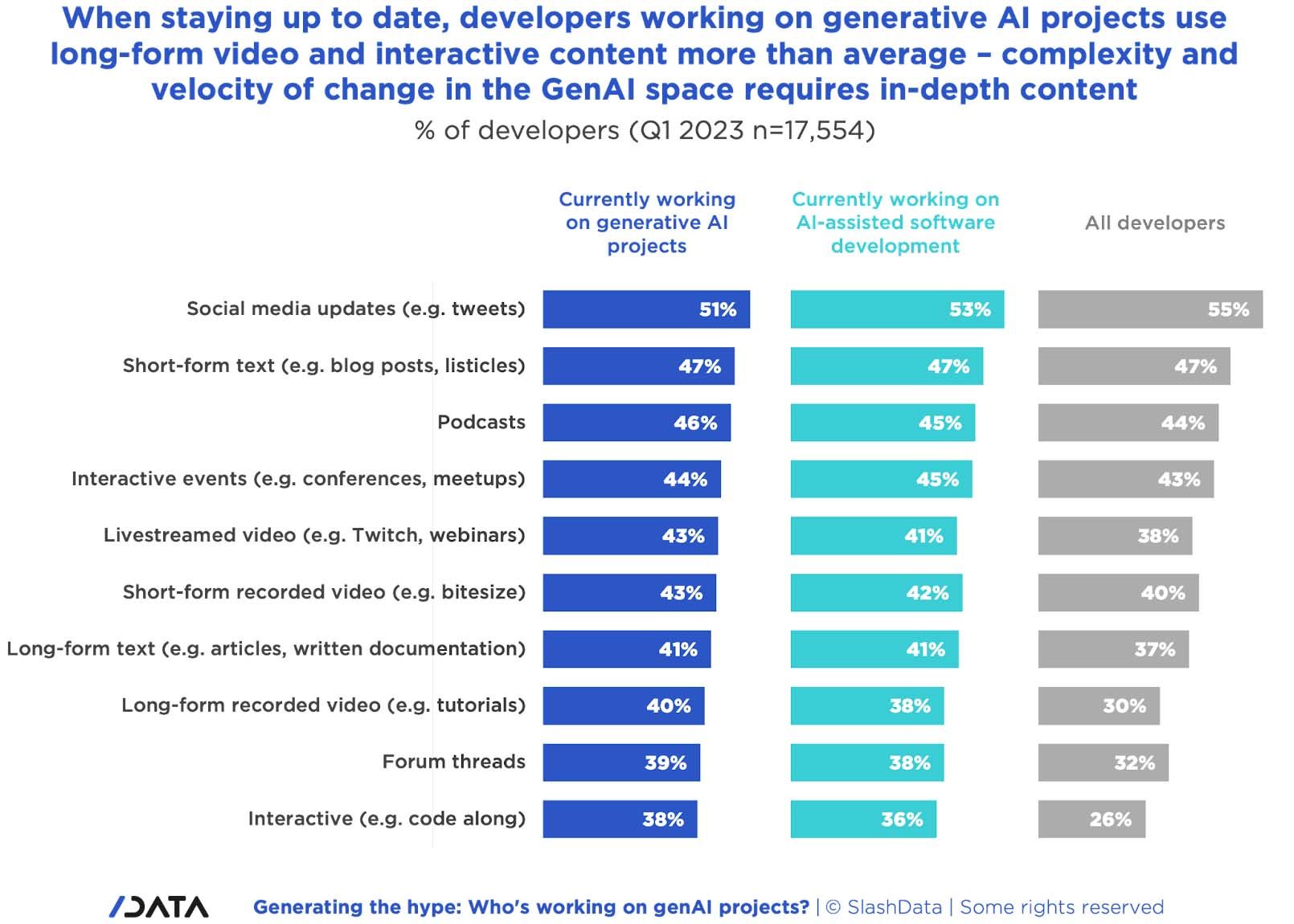
The survey also finds that, perhaps unsurprisingly, data scientists and machine learning developers are over-represented among those working on generative AI projects–these developers are more than twice as likely to identify as data scientists, ML developers, and data engineers. We also see that CIOs and CTOs are heavily involved too, perhaps because generative AI APIs may lower the barrier to including ML/AI in software projects, and technical leaders will be particularly interested in cost-savings and opportunities to build new products. Programmers without a specialization, on the other hand, are under-represented among developers working on generative AI projects, even when we consider AI-assisted software development.
We mentioned earlier that many developers who identify as currently working on AI-assisted development are likely using tools such as Github Copilot to increase their coding velocity, and although it’s still early days for this technology, it seems that developers working in unspecialised roles are not adopting it as quickly as others. Indeed, garden-variety programmers are some of the least likely to utilize AI-assisted development. Conversely, developers in specialized roles–architects, for example–seem to make much wider use of AI-assisted development and generative AI in general.
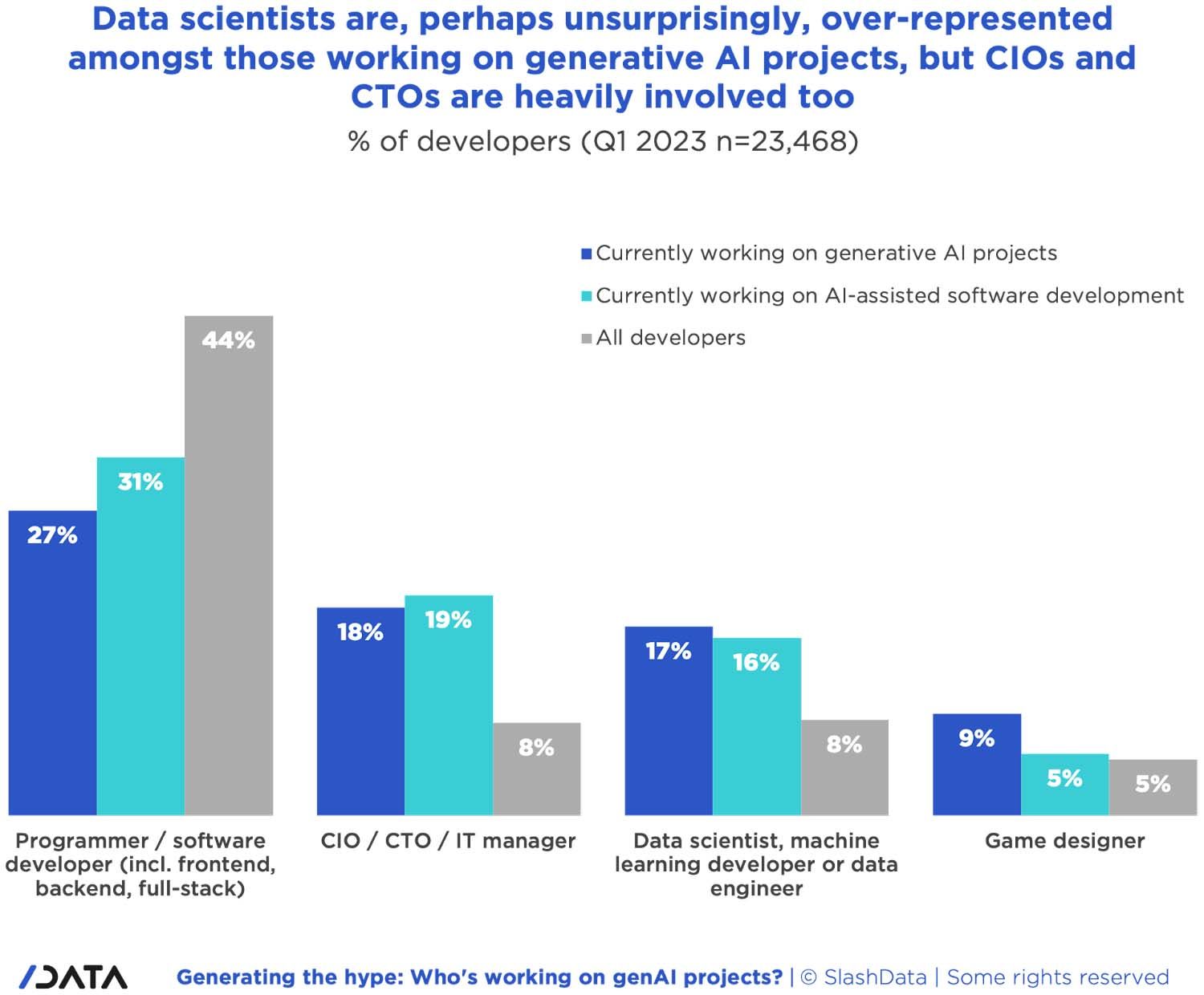
Talking Their Language: Where to Find Developers Involved in Generative AI
Now that we know more about which of developers work on generative AI projects, where they live, where they learned to code, and how they’re involved in software development, we turn to their behavior and preferences staying up to date.
Open-source communities are the most popular information source for developers working on generative AI who want to get information about software development, with official vendor websites and social media close behind. Compared to the average developer, there are no meaningful differences in these usage patterns. For devtool startups looking to meet developers who work on generative AI projects should likely prioritize these three information sources.
Further down the list, developers involved in generative AI use seminars, events, and meetups to get information about software development much more often than average. Startups looking to engage with developers in this space should consider creating and sponsoring such events to reach out to people who are, as we’ve discussed, likely to be highly educated, in specialized roles, and of middling experience levels. While developers involved in generative AI are currently concentrated in North America, events can help you connect to relevant communities as part of a larger growth strategy, even if your startup is located elsewhere.
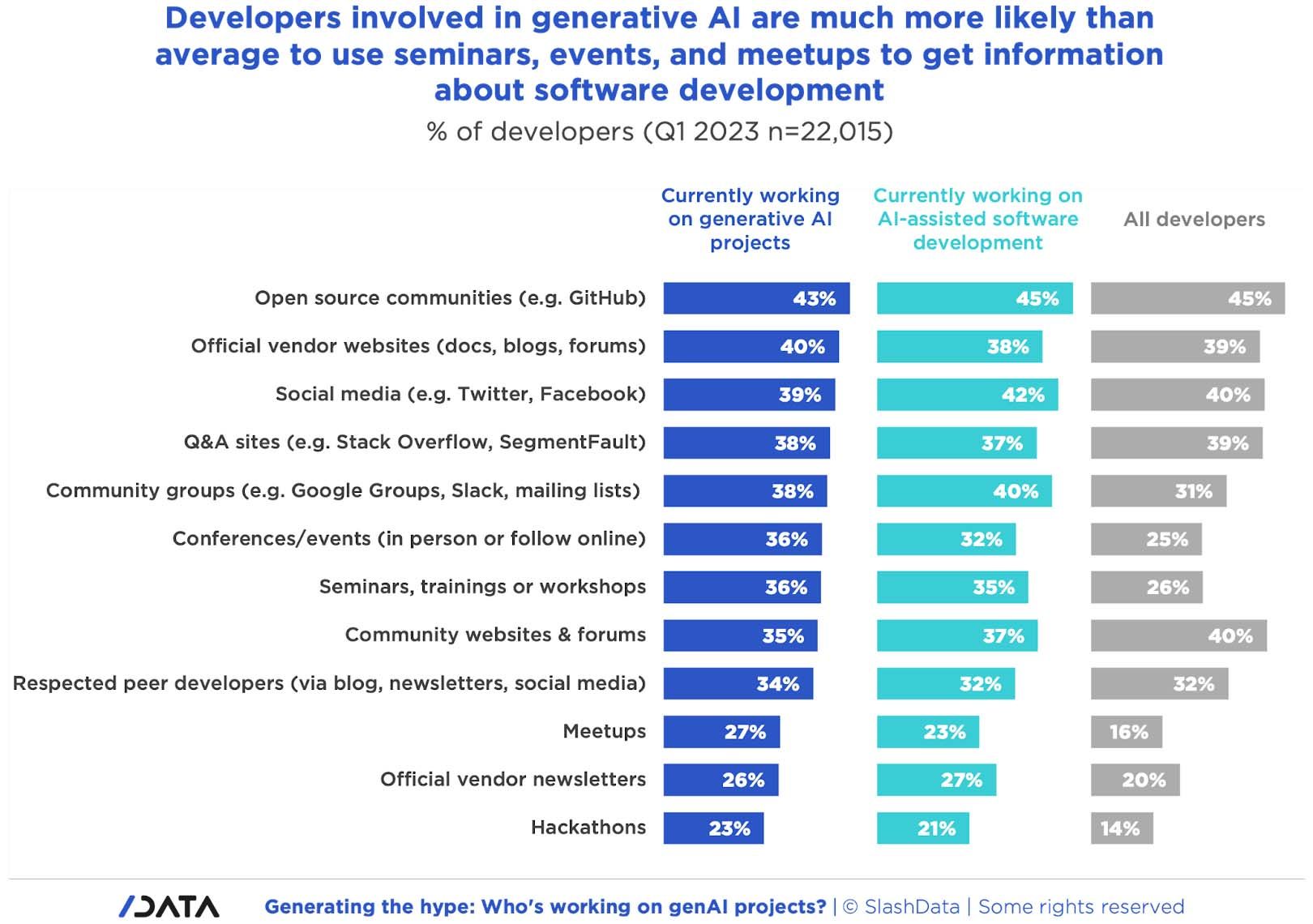
When looking at which types of content developers working on generative AI projects prefer to consume when staying up-to-date, we see that more than half–51% of those working on generative AI and 53% of those working on AI-assisted software development–prefer social media updates. Responding to the rapidly changing landscape of generative AI in a developer-focused way likely requires an active social media presence, and activity in open-source communities–even for startups whose product is proprietary, visibility in this space will help to raise awareness. Furthermore, for vendors wishing to tailor their website content to developers involved in generative AI, podcasts, long-form video, and interactive content should play an important role, as the complexity of the generative AI space requires in-depth content.

Conclusion
Because generative AI has only recently come into its own as a transformational technology, there are countless opportunities for innovation in the space. Startups looking to engage developers involved in these technologies will likely need a strong social media presence and visibility in relevant open-source software communities and at relevant events.To learn more about how AI is affecting software development at startups, join the DevGuild: Artificial Intelligence event.
Additional Resources
Subscribe to Heavybit Updates
You don’t have to build on your own. We help you stay ahead with the hottest resources, latest product updates, and top job opportunities from the community. Don’t miss out—subscribe now.
Content from the Library
The Role of Synthetic Data in AI/ML Programs in Software
Why Synthetic Data Matters for Software Running AI in production requires a great deal of data to feed to models. Reddit is now...
Data Council 2025: The Databases Track with Sai Krishna Srirampur and Craig Kerstiens
Heavybit is thrilled to be sponsoring Data Council 2025, and we invite you to join us in Oakland from Apr 22-24 to experience 3...
Platform Builders Ep. #1, The Future of CRM is No CRM with Justin Belobaba
In this inaugural episode of Platform Builders, hosts Christine Spang and Isaac Nassimi of Nylas welcome Justin Belobaba, Founder...